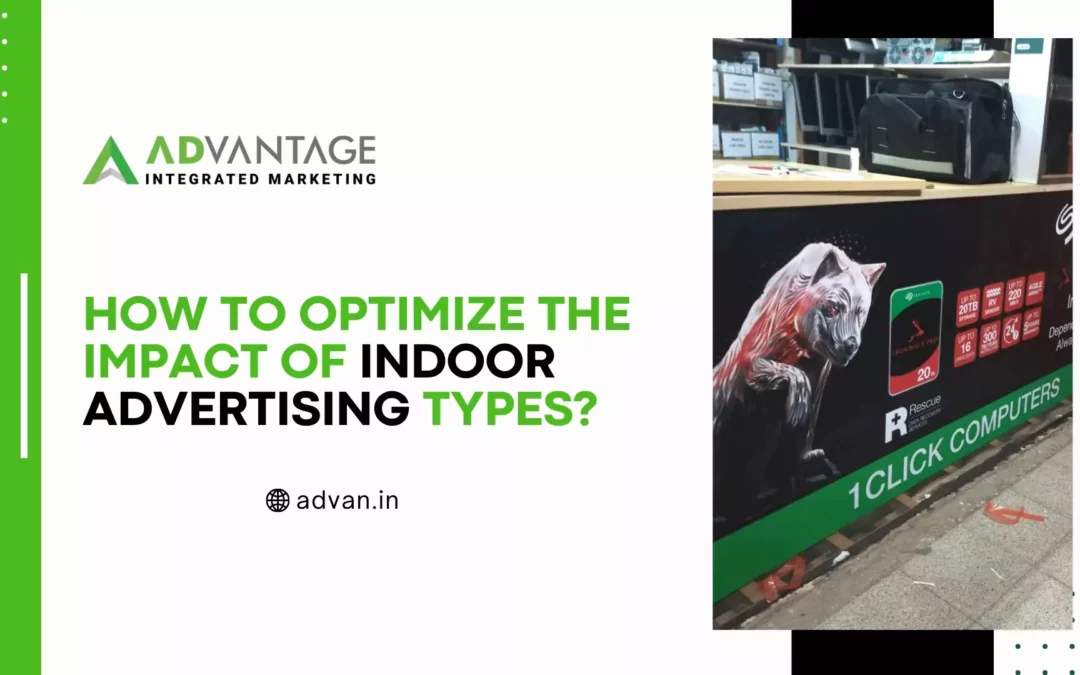“The future of advertising is the Internet.” – Bill Gates
Despite being quick, digital advertising has had a long and intense history. Technological advances over the course of the last 25 years have played an enormous part in the swift development of digital advertising.
The way that businesses reach and interact with consumers has radically changed as a consequence of technological advancements. From banner ads to artificial intelligence, digital advertising has chosen an elaborate path to deliver the right material to the right potential customer at the right time. Advertisers can offer pertinent messages to the suitable audience at the right time by examining customer behavior, demographics, and interests.
Through this blog, AD Vantage indoor advertising gives you a detailed understanding on how digital indoor advertising has evolved, offering the best results to the retail businesses.
The Rise of Digital Transformation in Indoor Advertising
From the time they wake up until the minute they go to bed, modern shoppers are constantly exposed to advertising through pop-up ads on their smartphones, banner ads on their favorite websites, and TV and radio ads during their favorite shows. This became the consistent scenario, especially during the COVID pandemic. Due to this, many customers had the tendency to simply ignore digital advertisements, when they were bogged up the huge flow of digital ads.
After the pandemic, customers returned to their favourite shopping destinations with a quest for retreating shopping experiences. Retail business are consistently in a pressure to find creative ways to cut through the clutter and get their own brand messages out in order to accomplish their goals.
Capturing all the verticals in advertising, digital technology has also created a buzz in indoor advertising in India. Creative indoor advertising with the latest digital indoor advertising products can help you reach the target customers effectively.
Indoor ads with a pinch of digital flavor attracts the customers, attracting them to their favourite products. The success of indoor advertising in malls is a perfect example for this where customers get deeply engaged with brands, leading to higher sales and revenue.
Evaluating digital indoor advertising advantages and disadvantages, advantages overshadow the disadvantages. This makes digital indoor ads a sizzling option for small and giant retail businesses.
Types of Digital Indoor Advertising Media
Let’s find out the two major types of indoor digital advertising.
Indoor LED Advertising
LED displays render clear, high-resolution visuals, letting the advertising content leap out and attract viewers’ attention. LED screens are suitable for indoor spaces with a variety of lighting situations because of their brightness and clarity.
Indoor LED advertising screens are capable of exhibiting dynamic material like animations, films, and interactive components. The impact advertising campaigns increases owing to the flexibility that allows them to design captivating and immersive experiences for their target audience.
Since indoor advertising display screens tend to come in an array of sizes and configurations, they are very flexible and convertible for varied indoor environments. To meet their unique requirements and fit inside the given location, advertisers can select from a variety of screen sizes, aspect ratios, and combos.
Compared with traditional advertising, indoor advertising LED screens like neon signs or fluorescent lights, LED technology is far more energy-efficient. LEDs have a lesser effect on the environment and consume less energy while still generating vivid and captivating sights.
There are many indoor LED advertising systems that allow for remote content management. Advertisers can smoothly adjust advertisements, target specific intervals, and provide real-time information or promotions by easily updating and organizing content remotely.
To target particular audiences, LED displays can be installed in strategic locations inside of buildings. For instance, displays can be positioned close to retail establishments to highlight significant product marketing or near to food courts to advertise dining options. Indoor LED advertising is more effective when it can target specific geographic regions and demographics.
To make the advertising experience more interactive and tailored, LED displays can be combined with additional technologies like sensors, cameras, or mobile apps. For instance, combining facial recognition software or mobile apps with LED displays might provide targeted and specialized content distribution.
To monitor audience engagement and ad performance, certain LED advertising systems provide analytics and measurement tools. Advertisers can gather information on measures like viewer impressions, dwell time, and interaction rates to assess the success of their campaigns with such metrics.
AI Signage
Digital signage is the practice of broadcasting dynamic advertising content on displays like LCD or LED panels. Businesses can use it to present customized advertisements, motion pictures, and interactive material to get people inside.
Artificial intelligence (AI) signages requires appropriate hardware, comprising displays (LED screens, video walls), cameras, sensors, and processing gear (media players or specialized AI-enabled devices). The signage system is built upon these elements.
Cameras and sensors are used by AI signage to gather a variety of data. While sensors may gather data like temperature, motion, or ambient light, cameras may capture video feeds or take photographs of the audience. These data are used as input for the AI algorithms, which then analyze and draw draw inferences.
To process and analyze the information collected, AI algorithms are fed. To extract useful information from the data, these algorithms utilize methods like computer vision, natural language processing, and machine learning.
Additional contextual factors are taken into consideration by AI algorithms to enhance the content’s relevancy and efficacy. This includes elements like the time of day, the weather, regional statistics, or historical information.
AI signages may dynamically change their content in accordance with the audience’s preferences and characteristics based on data analysis and knowledge of the environment. This could entail showing relevant advertisements, customized messages, or interactive content.
Top Technologies in Indoor Digital Advertising
Want to know about the top technologies in indoor digital ads? Let’s have a look.
Augmented Reality
With the aid of augmented reality (AR) technology, digital content may be superimposed over the physical world. AR can be applied to indoor advertising to create interactive environments where consumers can interact with virtual objects, try on virtual products and acquire more product information.
Beacon Technology
Beacons are tiny Bluetooth gadgets that send signals to nearby smartphones or tablets. Utilizing beacon technology, indoor advertising can target customers with personalized content, promotions, or location, data-based advertisements.
NFC technology
NFC, or Near Field Communications, permits wireless communication between devices by bringing them close together. It permits smartphone interactions with NFC-enabled tags or posters in indoor advertising, providing users access to additional content, discounts, or loyalty perks.
Facial Recognition
By identifying consumers and offering customized content or promotions based on their demographics, preferences, or previous interactions, facial recognition technology can be used in indoor advertising. With the implementation of this technology, customer experiences may be optimized and advertising messages can be customized.
Interactive Touchscreens
Interactive touchscreens allow users to engage with advertising content by interacting directly with the display. These touch-enabled screens can be used to provide product information, allow users to explore options, and even make purchases directly from the screen.
How to create effective digital campaigns for indoor advertising?
Indoor Advertising Materials
For effective attention-grabbing and message-transmission, selecting the appropriate indoor advertising materials is crucial. Think about utilizing attention-grabbing banners, digital displays, interactive screens, posters, and other visuals that are compatible with your business’s identity.
Utilize sturdy, high-quality materials that can withstand in indoor environments to maximize your return on investment and ensure longevity.
Indoor Advertising Tools
To boost the outcome of your ads, use indoor advertising platforms that offer significant targeting and customization options. Utilize analytics and data-driven insights to more fully comprehend your audience and modify your marketing initiatives.
Indoor Advertising Services
Working together with indoor advertising companies can make campaign planning and execution smoother. These experts offer knowledge in a variety advertising domains, including as campaign planning, content creation, and performance assessment.
The Benefits of Digital Indoor Advertising
The following are the benefits of digital indoor advertising campaigns.
Flexibility: Real-Time Updates and Responsiveness
The capacity to alter or update an advertisement’s targeting or content in real-time is commonly referred to as real-time updates. It could depend on a number of variables, including user activity, demographic data, or location. For instance, a real-time update of an indoor advertisement for a nearby restaurant’s daily specials based on the hour of the day is possible.
Responsiveness describes an indoor advertisement’s potential to adjust to various screen sizes and input methods. Digital indoor advertising media provides great responsiveness, where the retailers can integrate multiple ads in the same digital indoor ad campaign.
With digital indoor advertising strategies, incorporating responsiveness and real-time updates, retail business can create more relevant and compelling information that can boost engagement and conversions.
These capabilities may assist businesses in streamlining their indoor advertising campaigns and making sure that potential customers view their advertisements at the right time. With the apt digital indoor advertising products, customer engagement can be achieved to the maximum.
Data Collection: Tracking Customer Behaviour
Tracking customer behavior in indoor advertising may involve gathering information on how customers interact with and react to digital indoor advertising.
Video surveillance can record information on how many customers interact with the adverts, and how long they view them. Data on how customers walk around the indoor area and engage with the advertisements can be gathered by monitoring the strength and location of Wi-Fi signals.
Interaction: Engaging with the Audience
Compared to conventional static advertisements, digital indoor advertisements include a number of components that can assist engage consumers more successfully.
The ad can be made more interesting and interactive through the inclusion of films, animations, and interactive components like touchscreens or motion sensors.
Digital indoor ads can create a more personalized experience by providing pertinent content to particular audiences, increasing the likelihood that viewers will pay attention to the advertising. Digital advertisements are simple to update in real-time, enabling timely and pertinent advertising. Advertisers may produce interacting and persuading content that resonates with viewers and boosts engagement by understanding the interests, demands, and personal tastes of the target audience.
Advertisers can increase the reach of their advertisements and produce user-generated content through using hashtags or inviting viewers to share their opinions on social media. This fosters a sense of involvement and community around the brand or product.
Advertisers can create a captivating experience that draws in viewers and motivates them to spend more time interacting with the advertisement through the integration of interactive games, quizzes, or challenges.
Overall, the forecast for digital indoor advertising is favorable. Advertisers and companies will have greater opportunities to engage and connect with their target consumers in significant ways as advances in technology occur. Digital indoor advertising have the potential to change the advertising environment and produce significant returns for organizations in the future by embracing innovation, customization, and data-driven approaches.
Are you thinking of exploring the world of digital indoor advertising and skyrocket your sales? Contact AD Vantage today for classy indoor digital ads.








0 Comments